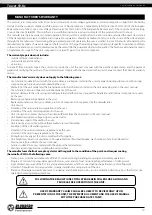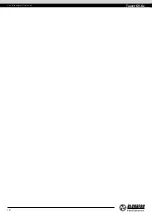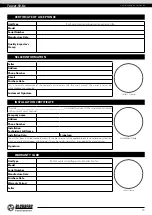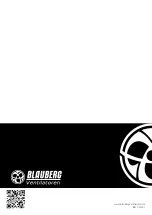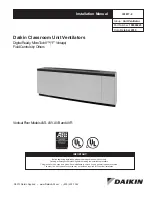
The fan fails to reach the
required rotation speed due to
serious overheating of the fan
motor.
Fan motor overloaded.
Eliminate the overload.
Improper fan starting method.
Use a soft starter or frequency converter to start the motor
(see “Asynchronous Electric Motor Starting Methods”
in the “Connection to power mains” section)
.
The fan motor runs at
overload capacity with current
consumption in excess of the
rated value.
The fan supplies more air than expected upon motor
capacity selection.
Measure network resistance. Throttle down the network
(add aerodynamic resistance to the air duct network).
Wrong motor phasing. The impeller rotates in the
opposite direction of the arrow on the fan casing.
If necessary, change the impeller rotation direction by
changing the phase sequence on the electric motor
terminals.
Air ducts clogged.
Clean the air duct or the impeller.
The fan supplies more air than
expected.
The resistance values used during the ventilation
network calculations are too conservative.
Check the air ducts for proper shape and cross section as
well as for any dampers present.
The cross section of air ducts increased and their
number reduced during the installation.
Throttle down the network (add aerodynamic resistance
to the air duct network).
Wrong choice of the fan.
Replace the fan with a unit of proper standard size.
The fan supplies less air than
expected.
Wrong calculation of the ventilation network and
wrong selection of the fan.
Re-calculate the network parameters and select a
matching fan.
The network resistance exceeds the design
calculations.
Re-arrange the ventilation network to decrease its
aerodynamic resistance.
Wrong direction of the impeller rotation.
If necessary, change the impeller rotation direction by
changing the phase sequence on the electric motor
terminals
(see the “Commissioning” section)
.
Air leak through a loose air duct connection.
Eliminate the air leak. Seal the air duct connection.
Impeller or air duct contamination with foreign
objects or debris.
Clean the impeller or the air ducts from foreign objects or
debris.
Excessive noise or vibration both
inside the fan and in the circuit.
Loose screw connections.
Check the screw connections for proper tightness.
No flexible joints between the fan and the ventilation
network on the suction and discharge sides.
Install flexible joints.
Loose connection of valves and dampers to the air
ducts.
Tighten up the fasteners of valves and dampers.
Impeller or air duct contamination with foreign
objects or debris.
Clean the impeller or the air ducts from foreign objects or
debris.
Worn bearings.
Replace the bearings.
Unstable power supply, unstable motor operation.
Check the stability of power supply parameters and
electric motor operation.
www.blaubergventilatoren.de
tower-sV-k2
15
Содержание Tower-SV-K2
Страница 1: ...Roof mounted centrifugal smoke extraction fan USER S MANUAL EN Tower SV K2...
Страница 7: ...Overall dimensions B A C H d 4 holes www blaubergventilatoren de Tower SV K2 7...
Страница 18: ...www blaubergventilatoren de Tower SV K2 18...
Страница 20: ...www blaubergventilatoren de B81 1EN 01...

















